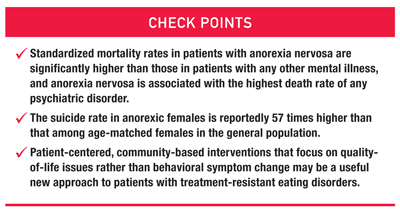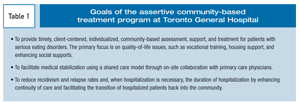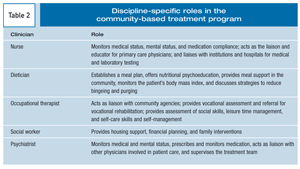Publication
Article
Psychiatric Times
Chronic Eating Disorders
Author(s):
A Different Approach to Treatment Resistance
Eating disorders in general and anorexia nervosa in particular are complex and difficult psychiatric disorders to treat. Empirical research has established effective treatments of bulimia nervosa. However, anorexia nervosa remains without effective empirically based treatments, especially for adult patients. A significant majority of patients with bulimia nervosa will have a good outcome; however, a small minority, approximately 10%, will be refractory to treatment.
In a review of anorexic inpatients and outpatients followed for a minimum of 4 years, good outcomes (weight restoration within 15% of recommended weight and regular menses) occurred in 44% of patients. Poor outcomes persisted in 24% of patients, and 28% had intermediate outcomes. An estimated 5% of patients died of the illness.1 As the duration of follow-up gets longer, the numbers are even more dismal. At a 10-year follow-up, more than 30% of patients were found to have anorexia nervosa that was refractory to treatment, with a further 10% of patients dying of the disease.2
The focus of this review is to describe clinically driven treatment strategies for patients with treatment-refractory eating disorders. Having said that, there is no widely accepted definition of treatment resistance in this population and criteria for the duration of illness and numbers of failed treatments do not exist. For anorexia nervosa and bulimia nervosa, treatment resistance is equivalent to chronicity or, as Strober3 describes, “a permanence of the disease state in spite of repeated exposures to state-of-the-art therapy.”

One may consider the definition of treatment resistance in bulimia nervosa to be that of a patient whose condition has not responded to an adequate trial of an SSRI and evidence-based psychotherapy, such as cognitive-behavioral therapy (CBT). A definition of treatment resistance for anorexia nervosa (of which there are no evidence-based treatments) may include repeated failure to reach or maintain 85% of ideal body weight following multiple attempts with psychosocial interventions (eg, CBT and psychodynamic therapy), efforts to treat comorbid psychiatric illnesses, and repeated attempts at intensive refeeding (usually in specialized inpatient or outpatient programs). Unfortunately, there are no reliable predictors to determine whether a patient is likely to fall into this category of chronic and refractory illness and thus prevention and treatment are extreme-ly challenging.3
After providing a brief overview of the diagnostic and epidemiological issues relevant to anorexia nervosa and bulimia nervosa, we focus on the clinical approach for patients with eating disorders. We follow with a discussion of an innovative model of care for patients with refractory eating disorders.
Diagnosis
The diagnostic criteria for anorexia nervosa and bulimia nervosa have changed throughout the history of DSM, but the characteristic features of an overvaluation of weight and shape in combination with abnormal patterns of eating and weight regulation remain primary symptoms in both disorders. Although the lifetime prevalence of anorexia nervosa has not changed dramatically during the past 20 to 30 years, aspects of its epidemiology have changed.
Previously, it was thought to be an illness that primarily affected female adolescents of higher socioeconomic classes. It is now recognized that anorexia nervosa exists within all socioeconomic groups and that women are falling ill both earlier and later in life.4 Unlike that of anorexia nervosa, the prevalence of bulimia nervosa increased dramatically during the 1980s and 1990s; however, since 2000, the incidence has decreased substantially.5 Anorexia nervosa affects 0.3% to 0.7% and bulimia nervosa between 1.5% to 2.5% of females in the general population, and the male to female prevalence ratio ranges from 1:6 to 1:10.6-8
Bulimia nervosa and anorexia nervosa are frequently chronic, unremitting conditions associated with significant morbidity and mortality. Standardized mortality rates in patients with anorexia nervosa are significantly higher than those in patients with any other mental illness, and anorexia nervosa has the highest death rate of any psychiatric disorder.9 Anorexic women are 12 times more likely to die than women of similar age in the general population; the most common causes of death are suicide and starvation-related medical complications. The suicide rate in anorexic females is reportedly 57 times higher than that in age-matched females in the general population.10
Treatment options
Based primarily on clinical experience, the mainstay of therapy for anorexia nervosa continues to be psychosocial interventions rather than medication. Pike and colleagues11 were the first to demonstrate the efficacy of individual psychotherapy after resolution of the acute phase of illness and following weight gain. Anorexic patients who were treated with CBT had less relapse and a significantly longer time until relapse than those who received only nutritional counseling.
More recently, McIntosh and colleagues12 found that nonspecific supportive clinical management was superior to more specialized psychotherapies, such as CBT and interpersonal psychotherapy, for the treatment of anorexia nervosa. Support for the efficacy of medications in the treatment of anorexia nervosa remains limited. The use of SSRIs, most commonly fluoxetine, has been studied in both open-label trials and double-blind randomized controlled studies; results fail to support a role for these agents in both underweight and weight-restored anorexic patients.13-15 Medications are indicated for treatment of comorbid illness, such as depression and anxiety, in the anorexic population, but the effectiveness of antidepressants is limited in the presence of starvation and emaciation.4
There is well-established support for the efficacy of CBT in bulimia nervosa as well as for medications.16 Antidepressants, including SSRIs (fluoxetine), tricyclic antidepressants, and monoamine oxidase inhibitors have been shown to reduce binge eating and purging in bulimia nervosa.17-20
Treating chronically ill patients can be difficult for clinicians. However, the nature of the symptoms of a chronic eating disorder makes treatment particularly challenging. Such patients often deny the severity of their illness; as a result, they resist treatment and their symptoms often develop a life of their own. Caloric restriction and binge eating and purging are self-reinforcing behaviors that lead to a starvation state and eventually become symptoms that are intractable and impervious to treatment.
There is an ego-syntonic pursuit of thinness in patients with eating disorders; what clinicians see as symptoms to be treated, patients see as lifestyle choices to be pursued. Issues of trust are prominent in patients with anorexia nervosa. As a consequence, these patients have difficulty in establishing a therapeutic relationship.
The change in focus to quality-of-life issues and away from ego-syntonic symptoms helps solidify the therapeutic alliance with caregivers and tends to decrease the power struggle that so often characterizes the relationship that develops. Strober3 outlines interventions that are useful for clinicians who treat these patients. Most important, he emphasizes the necessity of reassuring the patient that weight gain is not a primary objective and that steps toward weight gain are both collaborative and negotiable. Similarly, nutritional improvement should only be addressed once a therapeutic alliance is well established.
When efforts are made for weight gain, the goal may be to achieve a safe weight that is acceptable to the patient and compatible with medical stability and staying out of the hospital. Collaboration between therapist, dietician, and patient is essential before the implementation of any nutritional changes. A caloric goal of about 1200 kcal per day is often useful because it can be achieved by most patients and will not lead to significant weight gain but may be adequate for medical stabilization.3 Liquid supplements can reduce the osmotic load that accompanies the intake of solid food and that causes bloating and fluid retention in emaciated patients with anorexia nervosa. Such patients require medical monitoring by a primary care physician, including a full medical examination, regular laboratory measures, and ECGs.
The aforementioned strategies underline the importance of collaboration and communication among professionals, setting small achievable goals and, perhaps most important, establishing a strong therapeutic alliance.
A community-based, patient-centered approach

As with many chronic illnesses, the goals and expectations in patients with a treatment-resistant eating disorder shift from a focus on full recovery to symptom alleviation, improving the quality of life, and in the case of anorexia nervosa, the medical stability and a reduction in mortality. At Toronto General Hospital, we have implemented a client-centered, assertive community-based treatment approach for this group of patients.21 The approach is modeled after assertive community-based treatment programs that have been established for the seriously and persistently mentally ill, mostly patients with schizophrenia. The goals of this program for patients with a chronic treatment-resistant eating disorder are summarized in Table 1.

The multidisciplinary team that works with the patient is made up of a psychiatrist, a dietician, a nurse, a social worker, and an occupational therapist. The clinicians have both unique discipline-specific roles and shared clinical roles. All of the clinicians provide ongoing psychosocial support and meet with patients wherever they are most comfortable (eg, in the patient’s home, in a park). In addition, discipline-specific roles are clearly defined (Table 2).
The following case vignette briefly outlines some of the treatment approaches that are used in our model of care.
CASE VIGNETTE
Miss A, 45 years old, lives alone and does volunteer work. She has been receiving medical disability and has supported herself through social assistance. She has had anorexia nervosa, the restricting subtype, since she was 18 years old and has been hospitalized 17 times for her illness. At entry into the program, she weighed 63 lb (body mass index, 11). She had chronic suicidal ideation and had no interest in intensive inpatient eating disorder treatment.
Our team followed her in the community with the goal of improving her quality of life and trying to maintain some degree of medical stability (as opposed to disease management and weight gain). Treatment included ongoing psychosocial support, working with Miss A to develop a detailed safety plan for her chronic suicidal risk, and assessing and managing her considerable medical instability: she has severe osteoporosis and has sustained 4 fractures in the recent past. She is severely constipated, extremely weak, and tired, and has frequent episodes of dizziness and fainting and a history of seizures. On presentation, she had abnormal laboratory values, including elevated liver enzyme levels; decreased creatinine clearance; and decreased levels of albumin, white blood cells, and serum glucose. Her heart rate was 40 beats per minute.
The clinicians in the program spent a significant amount of time liaising with other supports, including her primary care physician and her family. They also set up a meal support program that was acceptable to the patient: it included liquid supplements and twice-weekly supervised lunches in her apartment.
With this support, Miss A has been maintained out of hospital for the past 2 years and is able to continue her volunteer work.
Conclusion
Improving our understanding of what contributes to treatment resistance in a patient who has an eating disorder will allow us to target new interventions specifically aimed at enhancing motivation and reducing resistance to behavioral and attitudinal change. As challenging and difficult as they may be, patients with chronic treatment-resistant eating disorders deserve our serious and committed attention. Warmth and genuineness, understanding and acceptance, and openness and honesty are all essential components of the effective and competent long-term care of patients with eating disorders. Especially for patients with chronic illness, clinicians must be prepared to accept the possibility that their most important function is to provide genuine human contact that focuses on quality of life and removes the sense of isolation and aloneness these patients feel.22
References:
References
1.
Steinhausen HC. The outcome of anorexia nervosa in the 20th century.
Am J Psychiatry.
2002;159:1284-1293.
2.
Ratnasuriya RH, Eisler I, Szmukler GI, Russell GF. Anorexia nervosa: outcome and prognostic factors after 20 years.
Br J Psychiatry.
1991;158:495-502.
3.
Strober M. Managing the chronic, treatment-resistant patient with anorexia nervosa.
Int J Eat Disord.
2004;36:245-255.
4.
Kaplan AS, Garfinkel PE. General principles of outpatient treatment. In: Gabbard G, ed.
Treatments of Psychiatric Disorders.
3rd ed. Washington, DC: American Psychiatric Press; 2001:2099-2117.
5.
Fairburn CG, Cooper PJ. The epidemiology of bulimia nervosa: two community studies
. Int J Eat Disord.
2006;2:61-67.
6.
Hoek HW, Bartelds AI, Bosveld JJ, et al. Impact of urbanization on detection rates of eating disorders.
Am J Psychiatry.
1995;152:1272-1278.
7.
Garfinkel PE, Lin E, Goering P, et al. Bulimia nervosa in a Canadian community sample: prevalence and comparison of subgroups.
Am J Psychiatry.
1995;152:1052-1058.
8.
Hoek HW, van Hoeken D. Review of the prevalence and incidence of eating disorders.
Int J Eat Disord
. 2003;34:383-396.
9.
Kaye WH, Frank GK, Bailer UF, Henry SE. Neurobiology of anorexia nervosa: clinical implications of alterations of the function of serotonin and other neuronal systems.
Int J Eat Disord.
2005;37:S15-S19.
10.
Keel PK, Dorer DJ, Eddy KT, et al. Predictors of mortality in eating disorders.
Arch Gen Psychiatry
. 2003;60:179-183.
11.
Pike KM, Walsh BT, Vitousek K, et al. Cognitive behavior therapy in the posthospitalization treatment of anorexia nervosa.
Am J Psychiatry
. 2003;160:2046-2049.
12.
McIntosh VV, Jordan J, Carter FA, et al. Three psychotherapies for anorexia nervosa: a randomized, controlled trial.
Am J Psychiatry
. 2005;162:741-747.
13.
Attia E, Haiman C, Walsh BT, Flater SR. Does fluoxetine augment the inpatient treatment of anorexia nervosa?
Am J Psychiatry.
1998;155:548-551.
14.
Strober M, Pataki C, Freeman R, DeAntonio M. No effect of adjunctive fluoxetine on eating behavior or weight phobia during the inpatient treatment of anorexia nervosa: an historical case-control study.
J Child Adolesc Psychopharmacol.
1999;9:195-201.
15.
Walsh BT, Kaplan AS, Attia E, et al. Fluoxetine after weight restoration in anorexia nervosa: a randomized controlled trial [published corrections appear in
JAMA.
2006;296:934 and 2007;298:2008].
JAMA
. 2006;295:2605-2612.
16.
Wilson GT, Fairburn CC, Agras WS, et al. Cognitive-behavioral therapy for bulimia nervosa: time course and mechanisms of change
. J Consult Clin Psychol.
2002;70:267-274.
17.
Goldstein DJ, Wilson MG, Thompson VL, et al. Long-term fluoxetine treatment of bulimia nervosa: Fluoxetine Bulimia Nervosa Research Group.
Br J Psychiatry
. 1995;166:660-666.
18.
Agras WS, Dorian B, Kirkley BG, et al. Imipramine in the treatment of bulimia: a double-blind controlled study
. Int J Eat Disord
. 1987;6:29-38.
19.
Walsh BT, Stewart JW, Roose SP, et al. Treatment of bulimia with phenelzine: a double-blind, placebo-controlled study.
Arch Gen Psychiatry.
1984;41:1105-1109.
20.
Bacaltchuk J, Hay P. Antidepressants versus placebo for people with bulimia nervosa.
Cochrane Database Syst Rev.
2003;(4):CD003391.
21.
Kaplan A, Rockert W, Rais H, et al. Assertive community treatment for chronic eating disorders: sample description and treatment outcome. Presented at: the 14th annual meeting of the Eating Disorder Research Society; September 25-27, 2008:159; Montreal.
22.
Kaplan AS, Garfinkel PE. Difficulties in treating patients with eating disorders: a review of patient and clinician variables.
Can J Psychiatry.
1999;44:665-670.





